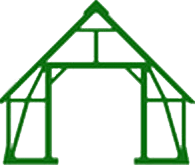
The barn, originally part of the Home or Hall Farm of nearby Upminster Hall, is a large timber framed structure clad in a mixture of horizontal and vertical boarding, capped by a thatched roof. It is of a box-frame construction with aisled sides, consisting of nine bays with central midstrey and a gabled porch on the northern side and measures some 138 feet long by approximately 40 feet wide.
Although now known locally as the “Tithe” barn, no evidence has been found that Waltham Abbey or other owners of the manor of Upminster Hall, to which the barn belonged, ever possessed the right to tithes. The only tithe barn known to have existed in Upminster formerly stood next to St Lawrence’s Rectory in St. Mary’s Lane, and was demolished in the 1860’s. The system of tithes dates from the early Hebrews, and taken up by the church, whereby a tribute or gift of a tenth of a man’s income paid in kind ie grain, wood, livestock and eggs, or profits of milling etc., were paid to support the poor. The tithe was later transferred to many secular owners as estates were sold and in the early part of the 19th century commutted to a cash payment, but finally abolished in 1938.
The manor of Upminster Hall was given by Earl Harold in or before 1062 to the Abbey of Waltham. According to the 18th century historian Philip Morant, Upminster Hall was likely to have been a retiring place or hunting seat for the Abbot and there was “A Chapel built of stone for the use of his tenants and dependants”. It is most likely that the barn was built by the Abbey around 1450; this date has now been confirmed by dendro-chronology on the main timbers. The rood has apparently always been covered with natural reed thatch (HEWITT, C.A. Development of Carpentry 1200 – 1700).
The manor remained in the possession of Waltham Abbey until its dissolution in 1540, when it was granted to Thomas Cromwell, Earl of Essex, reverting to the Crown that same year on his fall and execution. In 1543 it was sold to Ralph Latham, a goldsmith of London. After various changes of ownership the manor was sold in 1686 to Andrew Branfill, merchant and sea captain in whose family it remained until this century. The manor passed in direct line from his eldest son Champion (named after his father’s ship) to Champion IV Branfill who died in 1844. Ann Eliza Branfill, widow of the latter, continued as lady of the Manor until her death in 1873. Her second son Col. Benjamin Aylett Branfill, succeeded her, and was the artist for Wilson’s History of Upminster. On his death in 1899 it passed to trustees for his infant grandson Champion Andrew.
By 1906 much of the estate had been purchased for re-development by W.P.Griggs. The remainder, which included Upminster Hall and the barn, was acquired by 1921 by Godfrey Pike, who sold it in 1927 to the South Essex Brick and Tile Company. The company at once leased the hall itself and 6 ½ acres along the Ingrebourne to the Upminster Golf Club, which acquired the freehold in 1935. This same year the barn was separated from most of the estate and purchased with about 30 acres by Hornchurch Urban District Council in 1937.
The barn continued in agricultural use for some time after the area was developed for housing and playing fields in the 1950’s. In 1965 H.U.D.C had the corrugated iron roof stripped and re-thatched it with Norfolk Reed. Ownership then immediately passed to the London Borough of Havering on the formation of the Greater London Council.
After considerable debate as to the future of the barn, it was decided that Hornchurch & District Historical Society should use it for an Agricultural & Folk Museum. The barn is scheduled as an Ancient Monument.
